
Tulipa pulchella is a dwarf species of flowering plant in the family Liliaceae, native to Iran and Turkey. It grows from a bulb 1–2 cm diameter, which produces a flowering stem up to 20 cm tall. The leaves are glaucous-green, 10–15 cm long. The flowers are reddish-purple, with six tepals 3 cm long and 1.5 cm broad.

Tulipa turkestanica, the Turkestan tulip, is a species of tulip native to Central Asia. It was first described by Eduard August von Regel in 1873 as a variety of T. sylvestris, then elevated to full species status two years later.

Tulips are spring-blooming perennial herbaceous bulbiferous geophytes in the Tulipa genus. Their flowers are usually large, showy, and brightly coloured, generally red, orange, pink, yellow, or white. They often have a different coloured blotch at the base of the tepals, internally. Because of a degree of variability within the populations and a long history of cultivation, classification has been complex and controversial. The tulip is a member of the lily family, Liliaceae, along with 14 other genera, where it is most closely related to Amana, Erythronium, and Gagea in the tribe Lilieae.

Tulipa albanica is a flowering plant in the tulip genus, family Liliaceae that is native to Albania. It was discovered near the village of Surroj in Albania in 2010. The plant is a critically endangered (CR) as it grows in an area smaller than 100 ha, surrounded by mining activities.

Tulipa armena is a species of flowering plant in the Liliaceae family. It is referred to by the common name Armenian tulip, and is native to the historical Armenian Highlands as the name implies; current regions of Armenia, modern day Turkey, Iran, South Caucasus, and Azerbaijan.

Tulipa suaveolens, synonym Tulipa schrenkii, the van Thol tulip or Schrenck's tulip, is a bulbous herbaceous perennial of species of tulip (Tulipa) in the family of the Liliaceae. It belongs to the section Tulipa. It is the probable wild ancestor of the garden tulip.
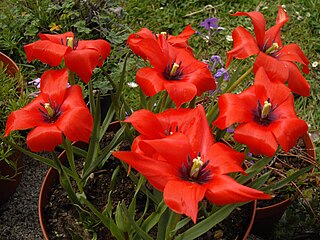
Tulipa linifolia, the flax-leaved tulip or Bokhara tulip, is a species of flowering plant in the tulip genus Tulipa, family Liliaceae, native to Tajikistan, Uzbekistan, northern Iran and Afghanistan. Growing to 20 cm (8 in) tall, it is a bulbous perennial with wavy red-margined sword-shaped leaves, and bowl-shaped red flowers in early to mid-spring. Each petal has blackish marks at the base.
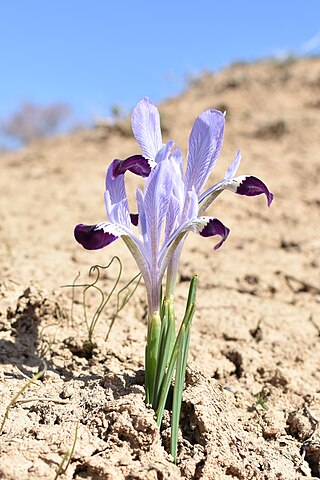
Iris kolpakowskiana, or Kolpakowski's iris, is a plant species in the genus Iris, it is classified in the subgenus Hermodactyloides and section Monolepsis. It is a bulbous perennial from Asia.
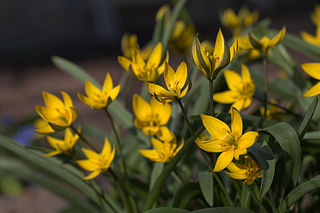
Tulipa dasystemon, synonym Tulipa neustruevae, is a bulbous herbaceous perennial species of tulip (Tulipa) in the family Liliaceae. It belongs to the section Biflores.
Tulipa aleppensis is a wild tulip in the family Liliaceae. It is native to Southeastern Turkey, Syria, near Beirut in Lebanon.
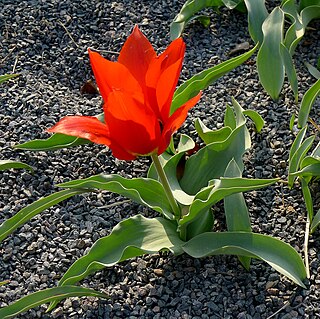
Tulipa eichleri, commonly known as Eichler tulip or Eichler's tulip, is a species of tulip. It is a bulbous flowering perennial with long green leaves,deep red flowers with a central black blotch, coming from the Caucasus Mountains.

Tulipa hungarica, the Danube tulip, Banat tulip or Rhodope tulip, is a species of flowering plant in the family Liliaceae. It is also in the subgenus Tulipa. It is found on the rocky mountainsides of Bulgaria, Romania, Hungary and Slovenia, especially along the gorges of the river Danube. It has small bright yellow flowers in spring and blue-grey leaves.

The taxonomy of Tulipa places the genus in the family Liliaceae, and subdivides it as four subgenera, and comprises about 75 species.
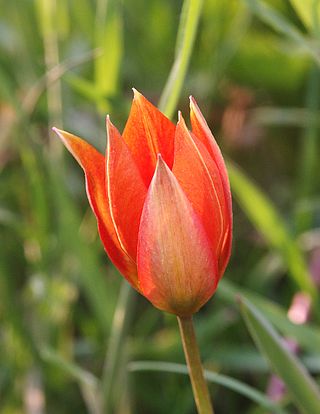
Tulipa orphanidea is a species of flowering plant in the Liliaceae family. It was described by Pierre Edmond Boissier and Theodor Heinrich Hermann von Heldreich (1862).

Tulipa montana is a species of tulip native to the mountains of Iran and Turkmenistan. With its deep red petals it has been proposed as a candidate for the Biblical Rose of Sharon, whose identity is unknown.

Tulipa biflora, the two-flowered tulip, is a species of tulip, native to the former Yugoslavia, Crimea, Anatolia, the Caucasus, southern Russia, Egypt, the Middle East, Central Asia, Iran, Pakistan, Afghanistan and Xinjiang in China. It has many synonyms, including Tulipa polychroma.

Tulipa fosteriana is a species of tulip, native to the Pamir Mountains and nearby areas of Afghanistan, Kyrgyzstan, Tajikistan and Uzbekistan.
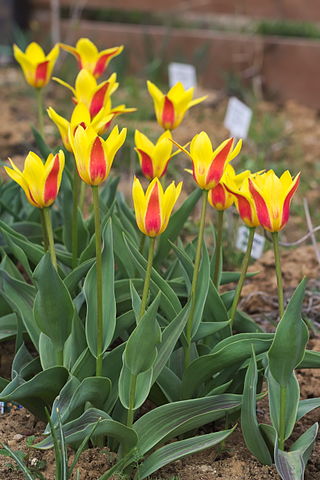
Tulipa kaufmanniana, the water lily tulip, is a species of tulip native to Central Asia.

Tulipa greigii, is a species of tulip native to Central Asia and Iran.

Tulipa praestans is a species of tulip native to the mountains of Tajikistan. Many well known cultivars have been formed from the original plant.



















